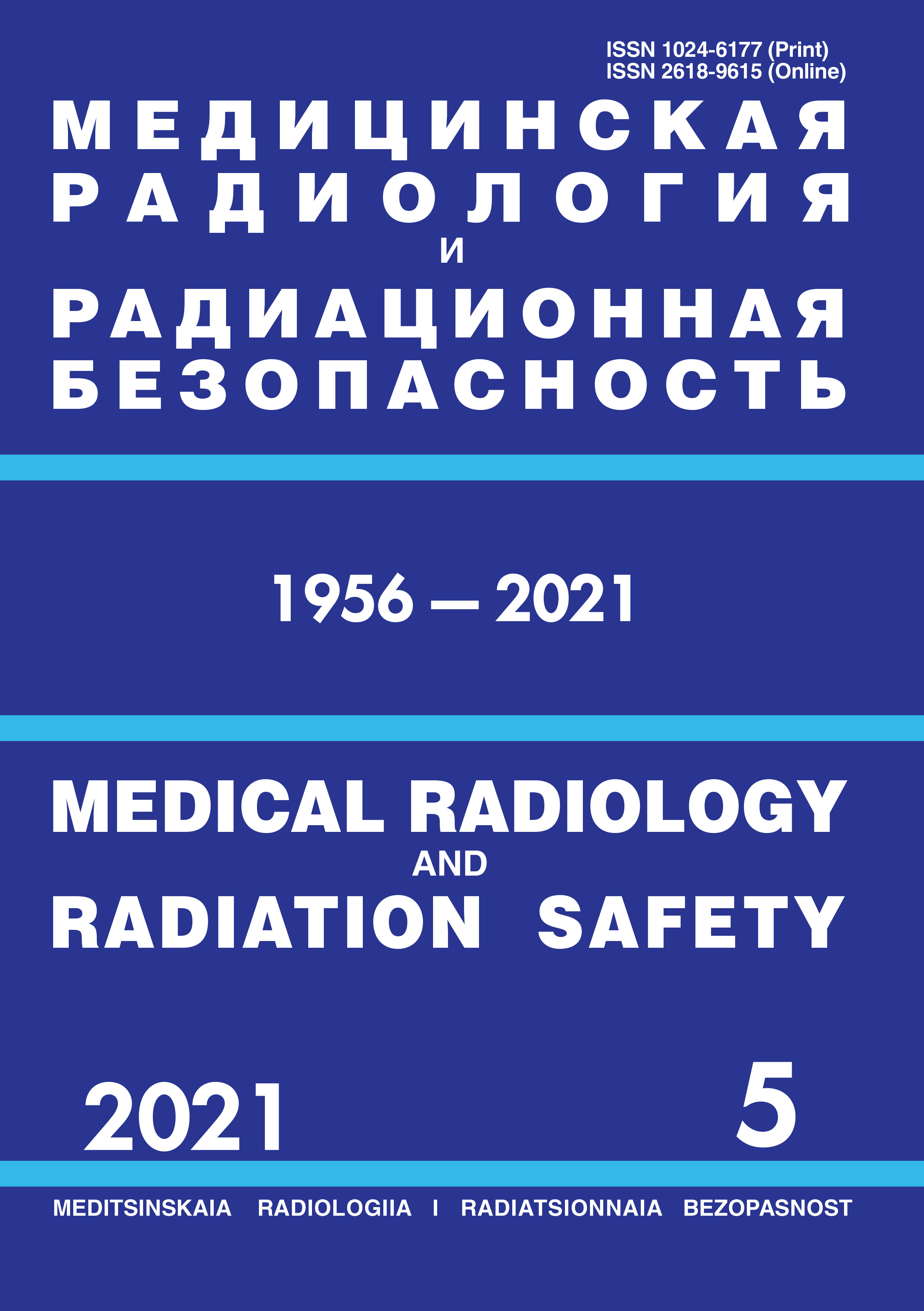Russian Federation
Russian Federation
Russian Federation
Russian Federation
Moscow, Russian Federation
Russian Federation
Moscow, Russian Federation
Russian Federation
Russian Federation
Russian Federation
Russian Federation
GRNTI 76.33 Гигиена и эпидемиология
GRNTI 76.03 Медико-биологические дисциплины
OKSO 31.06.2001 Клиническая медицина
OKSO 31.08.08 Радиология
OKSO 32.08.12 Эпидемиология
OKSO 14.04.02 Ядерные физика и технологии
BBK 534 Общая диагностика
BBK 51 Социальная гигиена и организация здравоохранения. Гигиена. Эпидемиология
TBK 5712 Медицинская биология. Гистология
TBK 5734 Медицинская радиология и рентгенология
TBK 6212 Радиоактивные элементы и изотопы. Радиохимия
TBK 5708 Гигиена и санитария. Эпидемиология. Медицинская экология
Purpose: To present the methods and results of studies of the factors of radiation exposure to workers involved in the manufacture of mixed uranium-plutonium nitride (MUPN) fuel at the complex experimental installations CEI-1 and CEI-2 of JSC SChC. Material and Methods: Regularities of the formation of external exposure doses have been revealed based on the study of the dynamics of the ambient dose equivalent rate (ADER) of photon and neutron radiation at the CEI-1 and CEI-2 workplaces, as well as instrumental individual dosimetric control of the equivalent doses to workers. In order to assess the inhalation intake and possible doses from internal irradiation, studies of the physicochemical properties of radioactive aerosols were carried out. Results: It has been found that the main sources of penetrating radiation in the premises of CEI-1 are boxes where tablets are pressed, chips and rejected tablets are crushed, as well as temporary storage of products is occurred. The highest ADER values have been measured in those boxes, where the radiation exposure was due to radioactive contamination caused by past activity, and is not associated with fabrication of MUPN fuel. A significant contribution of neutron exposure to individual doses of workers was measured, which exceeded the contribution of gamma exposure at some workplaces of the CEI-1. At CEI-2, a non-functioning exhaust ventilation pipe passing over the premises was found to be a powerful source of external radiation. This pipe contained a significant amount of radioactive material. Assessment of the contribution of gamma exposure from the ventilation pipe to the external exposure of workers reached 85% at some workplaces. Studies of the physicochemical properties of radioactive aerosols have revealed a high reactivity of MUPN compounds, leading to instant oxidation of the thoracic fraction of MUPN fuel aerosols under contact with air. The complex morphological and dispersed composition of aerosol particles in combination with a complex chemical composition caused by the aging processes of aerosols, can lead to a fundamental difference in the biokinetics of MUPN aerosols, the process of dose formation and, consequently, the degree of radiological hazard compared to those adopted in the ICRP models for U and Pu. The results of the current radiation-hygienic research are of a preliminary nature, since the object of this research is an experimental installation, which was used to develop a new technology for the production of MUPN fuel. The instrumental and methodological approaches to assess the factors of radiation exposure to workers tested at these experimental installations, will be used in the future to conduct similar studies during the pilot industrial operation of new modules for fabricating and refurbishing of MUPN fuel.
mixed nitride uranium-plutonium fuel, radiation safety, complex experimental installation, gamma and neutron exposure, radioactive aerosols
1. Rachkov V.I., Adamov E.O. Nauchno-tehnicheskie problemy ZYaTC dvuhkomponentnoy YaE i ih reshenie v PN «Proryv». V sb. dokladov otraslevoy konferencii po teme «Zamykanie toplivnogo cikla yadernoy energetiki na baze reaktorov na bystryh neytronah» 11-12 oktyabrya 2018 g. g. Tomsk, s.6 - 15.
2. Strategiya razvitiya atomnoy energetiki Rossii v pervoy polovine XXI veka. Osnovnye polozheniya. - M.: Minatom Rossii, 2000. - 26 s.
3. Proekt «Proryv» - tehnologicheskiy fundament dlya krupnomasshtabnoy yadernoy energetiki / Adamov E.O., Aleksahin R.M., Bol'shov L.A., Dedul' A.V., Orlov V.V., Pershukov V.A., Rachkov V.I., Tolstouhov D.A., Troyanov V.M. // Izvestiya Rossiyskoy akademii nauk. Energetika. - 2015. - № 1. - s.5 - 13.
4. Adamov E.O., Orlov V.V., Rachkov V.I., Slesarev I.S., Homyakov Yu.S.Yadernaya energetika s estestvennoy bezopasnost'yu: smena ustarevshey paradigmy, kriterii // Izvestiya Rossiyskoy akademii nauk. Energetika. - 2015. - № 1. - s.13 - 29.
5. Shultis, J. Kenneth; Richard E. Faw. str. 141, tabl. 6.2 // Fundamentals of Nuclear Science and Engineering. - CRC Press, 2008.
6. Physics and Fuel Performance of Reactor-Based Plutonium Disposition. Workshop Proceedings - Paris, France, 28-30 September 1998. Nuclear Energy Agency.
7. Habahpashev A.G. Spektr neytronov Po-α-O istochnika. Atomnaya energiya. Tom 7, vyp. 1. - 1959.
8. ICRP, 2008. Nuclear Decay Data for Dosimetric Calculations. ICRP Publication 107. Ann. ICRP 38 (3).
9. Alekseev S.V., Zaycev V.A. Nitridnoe toplivo dlya yadernoy energetiki: Moskva: Tehnosfera, 2013.
10. Murata T. et al., “Evaluation of the (α, xn) Reaction Data for JENDL/AN-2005,” JAEA-Research 2006-052 (Jul 2006) from URL https://wwwndc.jaea.go.jp/ftpnd/jendl/jendl-an-2005.html.
11. Al'fa-, beta- i gamma-spektroskopiya, pod red. K. Zigbana, per. s angl., v. 3 i 4, M., 1969.
12. Bondar'kov M.D., Zheltonozhskaya M.V., Maksimenko A.M., Sadovnikov L.V. Opredelenie soderzhaniya izotopov plutoniya v chernobyl'skih obrazcah po harakteristicheskomu Lx-izlucheniyu urana. PROBLEMI BEZPEKI ATOMNIH ELEKTROSTANCІY І ChORNOBILYa VIP. 2 2005 URL: http://dspace.nbuv.gov.ua/bitstream/handle/123456789/128042/17-Bondarkov.pdf?sequence=1
13. Andersen, A. A. 1966. A Sampler for Respiratory Health Hazard Assessement. Am. Ind. Hyg. Assoc. J., 27: 160-165.
14. ICRP. Age-dependent Doses to Members of the Public from Intake of Radionuclides: Part 4, Inhalation Dose Coefficients. ICRP Publication 71.Annals of the ICRP, Vol.25, № 3-4, 1995. Elsevier Science Ltd., Oxford.
15. Baranovskaya N.V., Ignatova T.N., Rihvanov L.P. Uran i toriy v organah i tkanyah cheloveka, Vestnik tomskogo gosudarstvennogo universiteta № 339, 2010, str.182-188.





